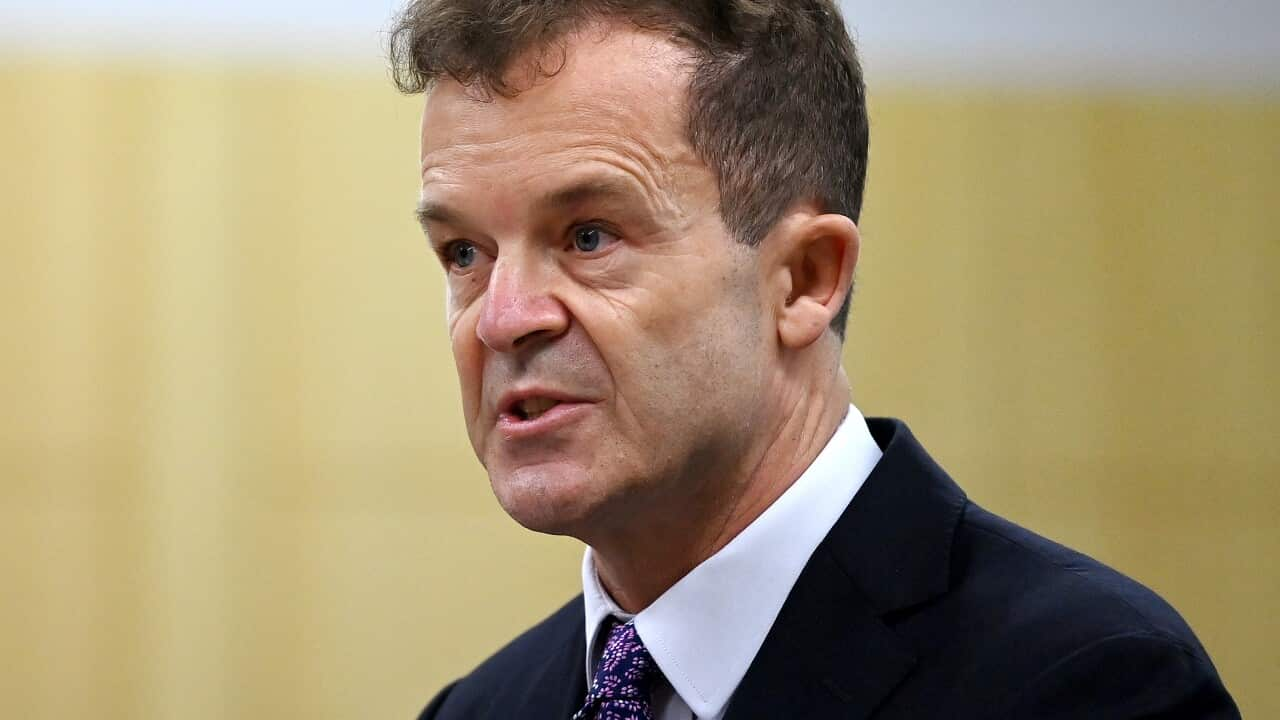Key Points
- One in four Australians will use technology to perpetrate abuse in their lifetimes, according to new ANROWS research.
- It says technology-facilitated abuse must be understood as a possible risk indicator for domestic and family violence.
This story contains references to domestic, family and sexual violence.
One in four Australians will use technology to perpetrate abuse in their lifetimes, according to new research, which found gaining or maintaining control to be the main motivation.
The report from Australia's National Research Organisation for Women's Safety (ANROWS) also found one in two Australians will be victims of technology-facilitated abuse (TFA), with one in three recent experiences occurring in a current or former intimate partner relationship.
ANROWS CEO Padma Raman PSM said the research offers new insights into what must be understood as "another form" of abuse and how, in some cases, it manifests as a possible risk indicator for domestic and family violence.
"The important thing to think about is technology is just another means of perpetrating abuse, and we haven't understood the extent and nature of how it's being used as yet another form of control," she told SBS News.
"I think this fills a really important gap [in knowledge] of a particular form of abuse, in looking at that perpetration and how that manifests."
ANROWS published two new research reports on Thursday, completing a national study that explored the extent and nature of, along with responses to, TFA in Australia.
Led by Dr Asher Flynn, from Monash University, and Dr Anastasia Powell, from RMIT University, this involved conducting a survey of 4,586 Australians aged over 18 over two years (2020 to 2022), along with 30 interviews with victims and survivors and perpetrators of this form of abuse.
What is technology-facilitated abuse?
Technology-facilitated abuse (TFA) is a growing social, legal and economic problem, with research suggesting perpetrators are commonly engaging in this form of abuse to harass, monitor, stalk and emotionally and psychologically harm victims and survivors, one report says.
It refers to TFA as "the use of mobile and digital technologies in interpersonal harms such as online sexual harassment, stalking or image-based abuse".
"Australian research has shown that TFA is a growing concern for service providers responding to domestic, family and sexual violence in particular, however to date, little is known about the extent of these harms within the Australian community," it states.
I don't think it's understood how widespread it is.ANROWS CEO Padma Raman
The research found that one in two Australians surveyed had experienced at least one TFA behaviour in their lifetime.
While it can occur in a range of contexts, about one in three victims and survivors reported their most recent experience occurred in a current or former intimate partner relationship.
The report found that women were significantly more likely to experience TFA perpetrated by a man, rather than a woman, in their most recent experience.
And, more women than men experienced TFA from an intimate or former partner.
'It has no borders'
The report acknowledges that gender is only one predictor of this form of abuse. Three in four LGBTIQ+ Australians, two in three Aboriginal and Torres Strait Islander people and three in five Australians with disability were among those who were most likely to have experienced TFA.
Ms Raman said temporary visa holders are particularly vulnerable to this form of abuse.
"The thing about technology is it means the abuser doesn't even have to be in the same country as the victim or the survivor. It has no borders," she said.
"This research gives us a little insight into it, alongside the other evidence that we have. It tells us it's a further way of compounding the experience of abuse that particularly vulnerable women face."
'150 calls in two hours'
The research found that one in four Australians self-reported engaging in at least one form of TFA in their lifetime.
The most common types were monitoring and controlling behaviours (33.7 per cent), emotional abuse and threats (30.6 per cent), and harassing behaviours (26.7 per cent).
About 24.6 per cent of those surveyed reported experiencing sexual and image-based abuse - though the report notes there were significant differences for some of these abuse types based on gender.
Examples included sending abusive or threatening messages, surreptitiously installing malicious software on a victim's and survivor's mobile phone, and repetitive and unwanted contact.
One study participant described calling an ex-partner about 150 times over a two-hour period.
I wanted an answer from her, and so I just called her about 150 times in, I don't know, a two-hour period. And she didn't pick up, but I just kept doing that.Study participant
The research found that this abuse was often undertaken through multiple channels and platforms.
One victim reported that her ex-partner would text and call her up to 50 times per day. When she would block his number, he would contact her on different platforms, such as through her work's Facebook account.
Every form of media I blocked him on, he'd find another way to contact me or make a new identity to contact me. Some of it was to tell me I'm a horrible person, I destroyed his life. The next one will be, 'You're my soulmate, I love you, the love of my life, can we please just talk, can we please just ...?'Study participant
Perpetrators commonly engaged in monitoring and controlling behaviours, primarily in intimate relationships, including monitoring their current or former partner's online interactions and technology use.
Victims and survivors commonly reported having their social media accounts hacked, as well as being monitored through CCTV, tracking devices, camera and audio bugs.
In some cases, this occurred while the couple was still together; in others it began as the relationship was breaking down or after they had broken up.
'I needed to retain hold of that life'
The research found that gaining and/or maintaining control over the victim and survivor was the main motivation behind this form of abuse.
One study participant said that "it was just this sense of control of being able to know where they were, what they were doing, who they were with".
In intimate partner relationships, perpetrators mainly identified feeling angry and upset, citing a loss of control at the end of a relationship and losing daily contact with the victim and survivor.
I needed to retain hold of that life, and that control of that person I guess, and I felt like if I could just track all that stuff, I could do that somehow.Study participant
The research found some perpetrators "minimised" their behaviour, with almost one in three saying they thought the victim would be "okay with it", one in six finding it was "funny" and one in 10 believing the victim would be "flattered".
"I think that tells us something about attitudes, and how maybe when it's done over technology, there's a sense of minimising the harm," Ms Raman said.
But in reality, she said, the harms experienced by victims and survivors can be lasting, complex and wide-ranging.
Why understanding technology-facilitated abuse matters
Ms Raman said it's crucial to understand the motivations and behaviours of perpetrators in order to detect and prevent this form of abuse - particularly in the context of
The term is used to describe a deliberate pattern of abuse occurring within intimate relationships and can include emotional and psychological manipulation along with social, financial and technology-facilitated abuse.
Of the respondents who reported experiencing TFA, many also reported the same perpetrator of their most recent incident had engaged in at least one form of additional abuse against them.
"I think we've traditionally seen family and domestic violence as physical abuse. And we're more and more understanding that it is many other forms of abuse that make up family and domestic violence," Ms Raman said.
"We need to understand the controlling behaviours a lot more. And often it is technology related."
According to the eSafety Commissioner, many of the behaviours that fall under technology-facilitated abuse are crimes under Australian law and can be reported to police before going to court.
Such laws cover behaviours such as stalking, sending threatening emails and texts, using tracking apps and spyware, online bullying and sharing intimate images or videos without consent.
But the researchers say police, internet platforms and other basic service providers -such as banks and gas or electricity providers - have inconsistent approaches to addressing abuse.
Ms Raman said frontline services must be able to understand and detect this form of abuse - and to offer support.
"We need to equip our frontline workers with knowledge of how this form of abuse is part of a wider suite of abusive patterns, and equip them with the solutions and support that women might need when they’re escaping or experiencing family and domestic violence," she said.
eSafety Commissioner Julie Inman Grant - whose eSafety Women team was represented on the ANROWS project advisory group - said the research reinforces what they've been hearing from services about online harms and the importance of targeted support for women experiencing intimate partner abuse.
“The crucial insights about the motivations and methods of those enacting this kind of abuse will improve the programs, training and outreach we provide to frontline services supporting people experiencing technology-facilitated abuse," she said.
If you or someone you know is impacted by family and domestic violence, call 1800RESPECT on 1800 737 732 or visit . In an emergency, call 000.
The Men’s Referral Service provides advice for men on domestic violence and can be contacted on 1300 766 491.













